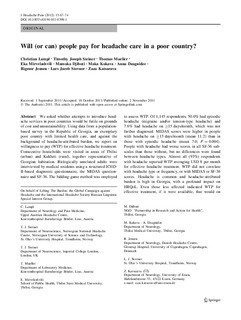| dc.contributor.author | Lampl, Christian | |
| dc.contributor.author | Steiner, Timothy J. | |
| dc.contributor.author | Mueller, T | |
| dc.contributor.author | Mirvelashvili, E | |
| dc.contributor.author | Djibuti, M | |
| dc.contributor.author | Kukava, M | |
| dc.contributor.author | Dzagnidze, A | |
| dc.contributor.author | Jensen, Rigmor | |
| dc.contributor.author | Stovner, Lars Jacob | |
| dc.contributor.author | Katzarava, Zaza | |
| dc.date.accessioned | 2019-10-11T08:34:50Z | |
| dc.date.available | 2019-10-11T08:34:50Z | |
| dc.date.created | 2012-01-16T12:09:43Z | |
| dc.date.issued | 2012 | |
| dc.identifier.citation | The Journal of Headache and Pain. 2012, 13 (1), 67-74. | nb_NO |
| dc.identifier.issn | 1129-2369 | |
| dc.identifier.uri | http://hdl.handle.net/11250/2621507 | |
| dc.description.abstract | We asked whether attempts to introduce headache services in poor countries would be futile on grounds of cost and unsustainability. Using data from a population-based survey in the Republic of Georgia, an exemplary poor country with limited health care, and against the background of headache-attributed burden, we report on willingness to pay (WTP) for effective headache treatment. Consecutive households were visited in areas of Tbilisi (urban) and Kakheti (rural), together representative of Georgian habitation. Biologically unrelated adults were interviewed by medical residents using a structured ICHD-II-based diagnostic questionnaire, the MIDAS questionnaire and SF-36. The bidding-game method was employed to assess WTP. Of 1,145 respondents, 50.0% had episodic headache (migraine and/or tension-type headache) and 7.6% had headache on ≥15 days/month, which was not further diagnosed. MIDAS scores were higher in people with headache on ≥15 days/month (mean 11.2) than in those with episodic headache (mean 7.0; P = 0.004). People with headache had worse scores in all SF-36 sub-scales than those without, but no differences were found between headache types. Almost all (93%) respondents with headache reported WTP averaging USD 8 per month for effective headache treatment. WTP did not correlate with headache type or frequency, or with MIDAS or SF-36 scores. Headache is common and headache-attributed burden is high in Georgia, with a profound impact on HRQoL. Even those less affected indicated WTP for effective treatment, if it were available, that would on average cover costs, which locally are low. Headache services in a poor country are potentially sustainable. | nb_NO |
| dc.language.iso | eng | nb_NO |
| dc.publisher | BMC (part of Springer Nature) | nb_NO |
| dc.relation.uri | http://www.springerlink.com/content/1gv7176734k27169/fulltext.pdf | |
| dc.rights | Navngivelse 4.0 Internasjonal | * |
| dc.rights.uri | http://creativecommons.org/licenses/by/4.0/deed.no | * |
| dc.title | Will (or can) people pay for headache care in a poor country? | nb_NO |
| dc.type | Journal article | nb_NO |
| dc.type | Peer reviewed | nb_NO |
| dc.description.version | publishedVersion | nb_NO |
| dc.source.pagenumber | 67-74 | nb_NO |
| dc.source.volume | 13 | nb_NO |
| dc.source.journal | The Journal of Headache and Pain | nb_NO |
| dc.source.issue | 1 | nb_NO |
| dc.identifier.doi | 10.1007/s10194-011-0398-1 | |
| dc.identifier.cristin | 886676 | |
| dc.description.localcode | Open Access This article is distributed under the terms of the Creative Commons Attribution 2.0 International License (https://creativecommons.org/licenses/by/2.0), which permits unrestricted use, distribution, and reproduction in any medium, provided the original work is properly cited. | nb_NO |
| cristin.unitcode | 194,65,30,0 | |
| cristin.unitcode | 1920,16,0,0 | |
| cristin.unitname | Institutt for nevromedisin og bevegelsesvitenskap | |
| cristin.unitname | Nevroklinikken | |
| cristin.ispublished | true | |
| cristin.fulltext | original | |
| cristin.qualitycode | 1 | |

